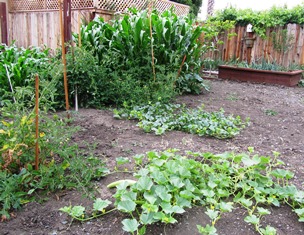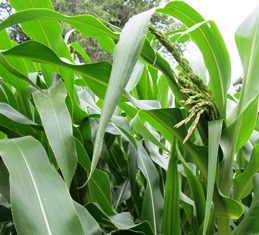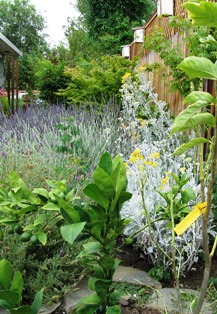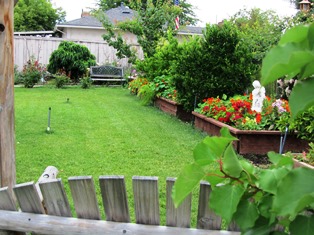Edible Landscape: Our Garden of Gentle Disorder
I’ve long been enamored of the traditional French jardin potager or ornamental, vegetable kitchen garden. The kitchen garden has its roots the medieval jardin de curé, described by garden author Jean-Paul Collaert in Kitchen Gardens of France, by Louisa James (Thames and Hudson 1999), as a “garden of lines . . . not dabs of color” as opposed to the English cottage garden and the traditional vicarage garden.
Most potagers grow the traditional four types of plants: vegetables, fruit, flowers, and herbs. What I love is the revival of interest worldwide in heirloom fruits and vegetables, which are perfectly suited for a kitchen garden. On my farmette, I grow plants almost exclusively from heirloom seed.

Corn, cucumber, and tomatoes share ground space; onions, garden peas, and eggplants thrive in boxes, table grapes spill over the fence
The medieval jardin de curé has been characterized by scholars as having plants in distinct beds laid out along formal lines (the Latin cross was popular). Gardening plots were defined by ge0metric shapes that could be quite complex (for example, the historic knot garden). Plants included herbs and flowers (many for medicinal uses), vegetables, berries, fruit trees, and ornamental trees and shrubs. This type of garden could be rustic or highly formal and could be found throughout France, from small farms and cloisters to country estates.
Our farmette garden has characteristics of the jardin potager and also the jardin de curé, although it could not be described as a true representation of either.
When we first moved to the farmette, we created and followed a master plan. The acreage follows a large rectangular-shape perimeter with our small house situated in the middle. Behind the house, a lawn is lined with gravel pathways. The pathways are dotted with boxes of herbs and flowers, mint, and berries. Between the boxes, the apricot, cherry, apple, fig, and persimmon trees are flourishing and producing bountiful crops.
In chaotic disorder, the beds of French perfume lavender and Spanish lavender that we planted have taken over one side of the property (much to the delight our honeybees), effectively erasing any lines that might have been obvious in an early layout. Interspersed with the lavender beds are iris, hydrangea, roses, lemon trees. Where the lavender turns a corner, bamboo creates a privacy screen, and then the fruit and flower-lined gravel path continues to the chicken house.
We moved dirt from the back half of the property and built a retaining wall along an L-shaped gravel path leading to a vegetable garden. Both sides of the path are lined with trees–apricot, pear, and pomegranate. On one side under a massive elm is a bed containing white geraniums and a variety of rose bushes.
We are following a plan for our own vision of a potager and, although I wish it had more of the lines of the medieval jardin de curé, our garden has the appearance of gentle disorder while being a prolific producer, in short, an edible landscape.
I love this living tableau. The appearance of the garden and grounds changes with the cycles of the seasons. Also ever-changing are the types of wildlife and songbirds frequenting the fountains and foraging on the fruits. There’s always something new to discover.
__________________________________________________________________
If you enjoy reading about farmette topics, gardening, and keeping chickens and honeybees, check out my series of cozy mysteries from Kensington Publishing in New York. Click on the link.
A HIVE OF HOMICIDES
 Facebook
Facebook Goodreads
Goodreads LinkedIn
LinkedIn Meera Lester
Meera Lester Twitter
Twitter









